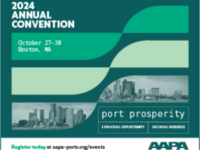INTERMODAL UPDATE – TRAINS: On-Dock Rail and Short Lines Are Critical
Infrastructure updates continue to change the Western Hemisphere railroad map as well as the scope and scale of train services. In addition, business deals, investments, personnel changes and technology are changing the outlook for train service.
* By Bridget Gorman Wendling *
Ports are the hubs for the ships, barges, trains and trucks that keep freight moving and advance national and international trade for countless industries that compete and thrive in the global marketplace. Recent federal reports forecast a 40 percent increase in U.S. freight shipments in the next 30 years. To handle their roles in the supply chain, ports must strategically plan and collaborate with partners to assess capital needs and invest in the equipment, infrastructure and technology to meet increased demand and the potential stress on the supply chain.
Increasing capacity and expanding on-dock rail operations are essential for ports, particularly as land resources become more constrained. Trains provide a fast and efficient method to transport cargo into and out of the congestion at the port. As volumes increase, inland rail terminals are also dealing with congestion issues. Because governance models vary from port to port, there is no blueprint for how to achieve increased capacity and efficiency.
AAPA’s State of Freight III revealed that 80 percent of AAPA ports are seeking to improve rail access, with 43 percent saying better access would add more than 25 percent throughput capacity. Ninety-three percent have some type of rail access, with 69 percent having on-dock rail and 72 percent having near-dock rail. However, the report notes that market forces are demanding that rail access be better coordinated, more efficient and more readily available to keep up with rising freight volumes and to meet increasingly tight timelines to accommodate customer and consumer expectations for just-in-time and overnight shipping.
Ken Spahn, northeast regional director, ports and intermodal, for Dewberry, has spent his career in and around ports. He echoes the two themes stakeholders seem to circle back to when discussing on-dock rail capacity, “For ports and their rail partners to strategically prepare for increased volume, they must assess their capabilities and needs and invest in infrastructure. Along with that, they need to keep pace with – and collaborate on – operational efficiencies and technological innovation to leverage what can be large investments. The experience in the Port of NY/NJ has been ‘build it and they will come’ as rail volume has quickly inundated new rail infrastructure.





